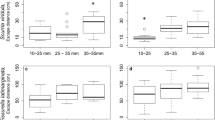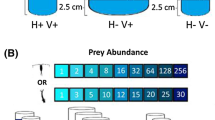Abstract
The predator Amoeba proteus induced behavioural and morphological changes in ciliates of the genus Euplotes. The frequency of avoidance behaviour in E. octocarinatus increased from 16±5% to 84±5% (SD) after 14 h of coexistence with the predator. The ciliate's width increased from 59±3 μm to 77±4 μm (SDM) within 48 h. Similar behavioural, but not morphological, change was induced in E. daidaleos, but neither morphological nor behavioural responses occurred in E. aediculatus. E. octocarinatus and E. daidaleos populations survived in the presence of A. proteus, whereas E. aediculatus populations became extinct by predation. Induced behavioural response seemed to be the reason for the low predation risk of E. octocarinatus and E. daidaleos. The results suggest that Euplotes ciliates have evolved specific defence mechanisms to various predators. Defensive changes are induced by a chemical substance released from A. proteus. This “kairomone” has a molecular weight between 5000 and 10000 Da. Proteolytic digestion of its activity indicated that the avoidance-inducing substance is a peptide. After the turbellarian Stenostomum sphagnetorum had induced a defensive morphology in E. octocarinatus or E. aediculatus, neither of these ciliates immediately avoided Amoeba proteus. Thus, Euplotes ciliates with a defensive morphology do not have behavioural defences in reaction to all predators.
Similar content being viewed by others
References
Appleton RD, Palmer AR (1988) Water-borne stimuli released by predatory crabs and damaged prey induced more predator-resistant shells in a marine gastropod. Proc Natl Acad Sci USA. 85:4387–4391
Black AR, Dodson SI (1990) Demographic costs of Chaoborus-induced phenotypic plasticity in Daphnia pulex. Oecologia 83:117–122
Brönmark C, Miner JG (1992) Predator-induced phenotypical change in body morphology in crucian carp. Science 258:1348–1350
Crowl TA, Covich AP (1990) Predator-induced life-history shifts in a freshwater snail. Science 247:949–951
Dawidowicz P, Pijanowska J, Ciechomski K (1990) Vertical migration of Chaoborus larvae is induced by the presence of fish. Limnol Oceanogr 35:1631–1637
Dodson SI (1984) Predation of Heterocope septentrionalis on two species of Daphnia: Morphological defenses and their cost. Ecology 65:1249–1257
Dodson S (1988) The ecological role of chemical stimuli for the zooplankton: predator-avoidance behavior in Daphnia. Limnol Oceanogr 33:1431–1439
Dodson SI (1989) The ecological role of chemical stimuli for the zooplankton: predator-induced morphology in Daphnia. Oecologia 78:361–367
Gilbert JJ (1966) Rotifer ecology and embryological induction. Science 151:1234–1237
Halbach U (1970) Die Ursachen der Temporalvariation von Brachionus calyciflorus Pallas (Rotatoria). Oecologia 4:262–318
Havel JE (1987) Predator-induced defenses: a review. In: Kerfoot WC, Sih A (eds) Predation, direct and indirect impacts on aquatic communities. University Press of New England, Hanover London, pp 263–278
Havel JE, Dodson SI (1984) Chaoborus predation on typical and spined morphs of Daphnia pulex: behavioral observations. Limnol Oceanogr 29:487–494
Hebert PDN, Grewe PM (1985) Chaoborus-induced shifts in the morphology of Daphnia ambigua. Limnol Oceanogr 30:1291–1297
Kuhlmann H-W (in press) Escape response of Euplotes octocarinatus to turbellarian predators. Arch Protistenkd
Kuhlmann H-W, Heckmann K (1985) Interspecific morphogens regulating prey-predator relationships in protozoa. Science 227:1347–1349
Kuhlmann H-W, Heckmann K (in press) Predation risk of typical and “winged” morphs of Euplotes (Protozoa, Ciliphora). Hydrobiologia
Kusch J (1993a) Induction of defensive morphological changes in ciliates. Oecologia 94:571–575
Kusch J (1993b) Predator-induced morphological changes in Euplotes (Ciliata): isolation of the inducing substance released from Stenostomum sphagnetorum (Turbellaria). J Exp Zool 265:613–618
Kusch J, Heckmann K (1992) Isolation of the Lembadion-factor, a morphogenetically active signal, that induces Euplotes cells to change from their ovoid form into a larger lateral winged morph. Dev Genet 13:241–246
Lampert W (1993) Ultimate causes of diel vertical migration of zooplankton: New evidence for the predator-avoidance hypothesis. Arch Hydrobiol Beih Ergebn Limnol 39:79–88
Lively CM (1986a) Canalization versus developmental conversion in a spatially variable environment. Am Nat 128:561–572
Lively CM (1986b) Competition, comparative life histories, and the maintenance of shell dimorphism in a barnacle. Ecology 67:858–864
Loose CJ (1993) Daphnia diel vertical migration behavior: Response to vertebrate predator abundance. Arch Hydrobiol Beih 39:29–36
Loose CJ, von Elert E, Dawidowicz P (1993) Chemically-induced diel vertical migration in Daphnia: a new bioassay for kairomones exuded by fish. Arch Hydrobiol 126:329–337
Lüning J (1992) Phenotypic plasticity of Daphnia pulex in the presence of invertebrate predators: morphological and life history response Oecologia 92:383–390
Neill WE (1990) Induced vertical migration in copepods as a defence against invertebrate predation. Nature 345:524–526
Parejko K, Dodson S (1990) Progress towards characterization of a predator/prey kairomone: Daphnia pulex and Chaoborus americanus. Hydrobiologia 198:51–59
Peckarsky BL (1980) Predator-prey interactions between stoneflies and mayflies: behavioral observations. Ecology 61:932–943
Riessen HP, Sprules WG (1990) Demographic costs of antipredator defenses in Daphnia pulex. Ecology 71:1536–1546
Sih A (1982) Foraging strategies and the avoidance of predation by an aquatic insect, Notonecta hoffmanni. Ecology 63:786–796
Sih A (1986) Antipredator responses and the perception of danger by mosquito larvae. Ecology 67:434–441
Stibor H (1992) Predator induced life-history shifts in a freshwater cladoceran. Oecologia 92:162–165
Tollrian R (1990) Predator-induced helmet formation in Daphnia cucullata (Sars). Arch Hydrobiol 119:191–196
Tollrian R (1991) Some aspects in the costs of cyclomorphosis in Daphnia cucullata. Verh Int Verein Limnol 24:2802–2803
Washburn JO, Gross ME, Mercer DR, Anderson JR (1988) Predator-induced trophic shift of a free-living ciliate: parasitism of mosquito larvae by their prey. Science 240:1193–1195
Wicklow BJ (1988) Developmental polymorphism induced by intraspecific predation in the ciliated protozoon Onychodromus quadricornutus. J Protozool 35:137–141
Yoshioka PM (1982) Predator-induced polymorphism in the bryozoan Membranipora membranacea (L.). J Exp Mar Biol Ecol 61:233–242
Author information
Authors and Affiliations
Rights and permissions
About this article
Cite this article
Kusch, J. Behavioural and morphological changes in ciliates induced by the predator Amoeba proteus . Oecologia 96, 354–359 (1993). https://doi.org/10.1007/BF00317505
Received:
Accepted:
Issue Date:
DOI: https://doi.org/10.1007/BF00317505




